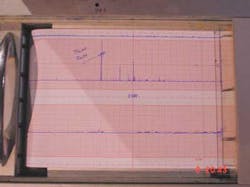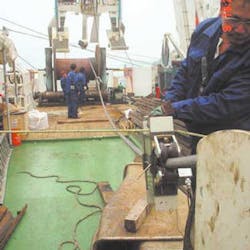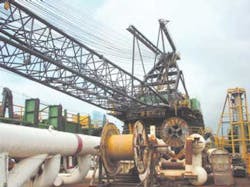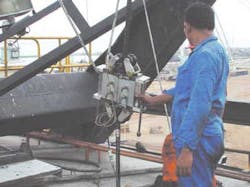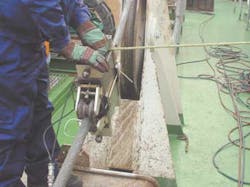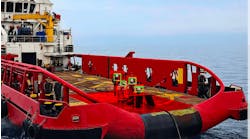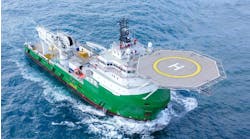HEAVY LIFT TECHNOLOGY: How magnetic testing is being used to examine wire rope interior
Since the Gulf of Mexico accident in 1998 in which a 2-1/4-in. diameter hoisting wire rope ruptured while lifting a top-side module for a Spar platform, operators and contractors have come to realize that steel wire ropes can and do suffer catastrophic failure.
Besides visual observation and sectional and pull tests, a way to test wire ropes without damaging or stressing them has been existence for years, although its use offshore is relatively new. Magnetic rope testing (MRT) involves the magnetic flux in a steel rope, which is directly proportional to the steel area. Measuring the flux density therefore measures the area of the steel rope.
The principle of MRT (electromagnetic or EM testing) is to magnetically saturate a section of the wire rope as it passes through a set of permanent magnets. Sensors detect disturbances to the field, which are attenuated to correct for any speed variations. The signal is displayed as a graphical trace. The trace delivers two primary sets of information:
- Extent of the occurrence of broken wires
- Amount of steel loss due to wear and corrosion damage.
An MRT operator can use the signal to detect the location of the degradation and make an assessment of severity using visual and MRT evidence. The approximate reduction in rope strength can be fairly accurately estimated. The entire length of the wire rope can be tested and the complete cross section of the rope examined. MRT detects broken wires or corrosion damage on the inside of the rope not visible to an external visual inspection.
Several offshore contractors have begun using MRT, coupled with discard criteria, for determining whether to remove a wire rope. The equipment has been modified to make it more portable, compact, lighter, and more sensitive to flaw detection. A good service provider should be able to perform the test on-board a rig in the middle of the ocean.
How failure begins
The steel core of a wire rope used in a hoisting application is susceptible to two main forms of degradation. First, there is accelerated fatigue of the wires. The outer strands accelerate fatigue of the wire in the rope core due to the inward pressure exerted on the core as soon as the rope comes under a tension or bending stress.
As the outer strand wires are typically much larger than the core wires against which they come into contact, this has the effect of raising the contact stress in the core wires. The result is that the fatigue limit of these core wires is reached within a much shorter period of time than is the case for the outer wires.
Open up any hoist rope that has achieved 70% of its expected life, and you will typically find numerous broken wires at the steel core, while the outside of the rope still appears to be in good shape.
Secondly, due to the physical structure of the wire rope, seawater becomes trapped inside and sets up a form of corrosion attack known as crevice corrosion. Even after the rope appears dry from the outside, the water remains trapped between the crevices of the individual rope strands.
Crevice corrosion is a self-accelerating process. The attack is intensified as time goes on. This means that the wire rope installed on the derrick barge crane may be undergoing internal corrosion at an ever-increasing severity rate well after completion of a specific project.
The nature of offshore operations and the MRT brings these two factors together. Internal degradation of the wire rope due to fatigue and corrosion is potentially the most insidious form of damage. MRT can be used to detect internal degradation, rather than physically opening the wire rope strands to make a visual inspection.
Inspection methods
The most common form of wire rope inspection is the visual method. While this method can detect damage to the wire rope on the outside, it is inadequate for assessing internal conditions of the wire rope. Another common test is to cut a sample of the rope from either end of the wire and perform a test to destruction to determine the actual breaking force of the wire rope.
As long as this test meets or exceeds the minimum breaking load (MBL), the rope is considered fit for use. However, the results obtained are only true for specific tested samples and not necessarily the remainder of the untested wire rope. Compounding this is the fact that the end of the wire rope where the sample is taken is often the least hard working and least exposed part of the entire rope length.
The industries involved in shaft mining have used MRT methods for some years to reduce the costs of heavy-lift operations. Most of the improvements in the MRT process, including using and interpreting the data, have already been done by the shaft mining industries.
One method of improving evaluation of cables offshore is to establish a steering committee to set guidelines for the use of MRT to ensure consistency, equal participation, and sharing the burden of research among operators.
In the shaft mining industry in South Africa, MRT is conducted at 6-month intervals to meet legal requirements for all ropes over one year old. In North America and Europe, MRT is widely used in shaft mining, and the training of testing personnel and acceptable discard criteria for wire ropes have been standardized and are being continually improved. Mining houses, wire rope manufacturers, and MRT services have worked closely to achieve levels of competence. They have turned MRT into a specialized discipline in its own right.
As more and more projects move to deepwater and the equipment to support this movement becomes heavier and longer, the stresses exerted on wire ropes are increasing.
Author
Mark GJ Beretta is the Marketing Director for Kim Teck Leong Offshore Pte Ltd., based in Singapore. He has 15 years experience working in the wire rope industry, 12 of which were spent as Technical Director at Haggie Rand in South Africa.

